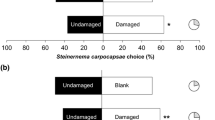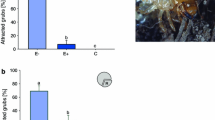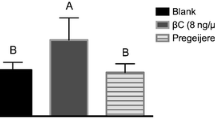Abstract
Background and aim
Entomopathogenic nematodes (EPN) use odor cues to locate and infect their insect hosts in the soil, making them an important tool in sustainable management of agricultural insect pests. However, very little information is available on the role of soil bacteria in mediating belowground interactions between plants, herbivores and the EPN. In this study, a maize-herbivore-entomopathogenic nematode complex was used to investigate the effect of plant root colonization by a soil bacterium on belowground tritrophic interactions.
Methods
The impact of maize root colonization by Bacillus pumilus strain INR-7 on the preference of the EPN, Heterorhabditis bacteriophora was tested in four arm olfactometer bioassays in the presence or absence of the root herbivore Diabrotica virgifera LeConte (Coleoptera: Chrysomelidae). Plant volatiles were collected for profile characterization. Further preference assays were performed using plant volatile extracts and synthetic volatiles.
Results
In the absence of the root herbivore, the nematodes were attracted to maize roots whose seeds were coated with dead and living bacteria. In the presence of the herbivore, the nematodes selectively oriented towards infested plants whose seeds were treated with B. pumilus strain INR-7 than dead bacteria treated, untreated plants or sunshine sand mix. In contrast, plant volatile extracts or pure compounds did not reproduce the observed behavior.
Conclusions
The study showed that bacterial coating of maize seeds with the tested strain may play an important role in shaping belowground tritrophic interactions through mechanisms that would require further investigations. The potential of B. pumilus strain INR-7 integration in maize rootworm management program is discussed.


Similar content being viewed by others
References
Adesemoye AO, Torbert HA, Kloepper JW (2008) Enhanced plant nutrient use efficiency with PGPR and AMF in an integrated nutrient management system. Can J Microbiol 54:876–886
Adesemoye AO, Torbert HA, Kloepper JW (2010) Increased plant uptake of nitrogen from 15N-depleted fertilizer using plant growth-promoting rhizobacteria. Appl Soil Ecol 46:54–58
Ali JG, Alborn HT, Stelinski LL (2010) Subterranean herbivore-induced volatiles released by citrus roots upon feeding by Diaprepes abbreviatus recruit entomopathogenic nematodes. J Chem Ecol 36:361–368
Anbesse S, Ehlers RU (2013) Heterorhabditis sp. not attracted to synthetic (E)-β-caryophyllene, a volatile emitted by roots upon feeding by corn rootworm. J Appl Entomol 137:88–96
Battaglia D, Bossi S, Cascone P, Digillo MC, Prieto JD, Fanti P et al (2013) Tomato below ground-above ground interactions: Trichoderma longibrachiatum affects the performance of Macrosiphum euphorbiae and its natural antagonists. Mol Plant-Microbe Interact 26(10):1249–1256
Chandler LD (2003) Corn rootworm areawide management program: United States Department of Agriculture-Agricultural Research Service. Pest Manag Sci 59:605–608
Chiriboga X, Guo H, Campos-Herrera R, Röder G, Imperiali N, Keel C et al (2018) Correction to: root-colonizing bacteria enhance the levels of (E)-β-caryophyllene produced by maize roots in response to rootworm feeding. Oecologia 187(2):459–468
D’Alessandro M, Erb M, Ton J, Brandenburg A, Karlen D, Zopfi J et al (2014) Volatiles produced by soil-borne endophytic bacteria increase plant pathogen resistance and affect tritrophic interactions. Plant Cell Environ 37:813–826
Disi JO, Zebelo S, Ngumbi E, Fadamiro HY (2017) cis-Jasmone primes defense pathways in tomato via emission of volatile organic compounds and regulation of genes with consequences for Spodoptera exigua oviposition. Arthropod Plant Interact 11(4):591–602
Disi JO, Zebelo S, Kloepper JW, Fadamiro HY (2018a) Seed inoculation with plant growth-promoting rhizobacteria affects European maize borer oviposition on maize plants. Entomol Sci 21(1):48–58
Disi JO, Kloepper JW, Fadamiro HY (2018b) Seed treatment of maize with Bacillus pumilus strain INR-7 affects host location and feeding by Western corn rootworm, Diabrotica virgifera virgifera. J Pest Sci 91(2):515–522
Domenech J, Reddy MS, Kloepper JW, Ramos B, Gutierrez-Maῇero J (2006) Combined application of the biological product LS213 with Bacillus, Pseudomonas or Chryseobacterium for growth promotion and biological control of soil-borne diseases in pepper and tomato. BioControl 51:245–258
Duffey SS, Stout MJ (1996) Antinutritive and toxic components of plant defense against insects. Arch Insect Biochem Physiol 32:3–37
Guerrieri E, Lingua G, Digilio MC, Massa N, Berta G (2004) Do interactions between plant roots and the rhizosphere affect parasitoid behaviour? Ecol Entomol 29:753–756
Hiltpold I, Toepfer S, Kuhlmann U, Turlings TCJ (2010) How maize root volatiles affect the efficacy of entomopathogenic nematodes in controlling the western corn rootworm? Chemoecology 20:155–162
Hiltpold I, Erb M, Robert CA, Turlings TCJ (2011) Systemic root signalling in a belowground, volatile-mediated tritrophic interaction. Plant Cell Environ 34(8):1267–1275
Imperiali N, Chiriboga X, Schlaeppi K et al (2017) Combined field inoculations of Pseudomonas Bacteria, arbuscular mycorrhizal Fungi, and Entomopathogenic nematodes and their effects on wheat performance. Front Plant Sci 8:1–17
Jenkins WR (1964) A rapid centrifugal-floatation technique for separating nematodes from soil. Plant Dis Rep 48:692
Jetiyanon K, Kloepper JW (2002) Mixtures of plant growth-promoting rhizobacteria for induction of systemic resistance against multiple plant diseases. Biol Control 24:285–291
Kloepper JW, Ryu C-M, Zhang S (2004) Induced systemic resistance and promotion of plant growth by Bacillus spp. Phytopathology 94:1259–1266
Köllner TG, Schnee C, Gershenzon J, Degenhardt J (2004) The variability of sesquiterpenes emitted from two Zea mays cultivars is controlled by allelic variation of two terpene synthase genes encoding stereoselective multiple product enzymes. Plant Cell 16:1115–1131
Köllner TG, Held M, Lenk C, Hiltpold I, Turlings TCJ, Gershenzon J et al (2008) A maize (E)-β-caryophyllene synthase implicated in indirect defense responses against herbivores is not expressed in most American maize varieties. Plant Cell Online 20:482–494
Liu K, Garrett C, Fadamiro H, Kloepper JW (2016) Induction of systemic resistance in Chinese cabbage against black rot by plant growth-promoting rhizobacteria. Biol Control 99:8–13
Meihls LN, Higdon ML, Siegfried BD, Miller NJ, Sappington TW, Ellersieck MR, Spencer TA, Hibbard BE (2008) Increased survival of western corn rootworm on transgenic corn within three generations of on-plant greenhouse selection. Proc Natl Acad Sci 105:19177–19182
Meihls LN, Higdon ML, Ellersieck M, Hibbard BE (2011) Selection for resistance to mCry3A-expressing transgenic corn in western corn rootworm. J Econ Entomol 104:1045–1054
Meinke LJ, Siegfreid BD, Wright RJ, Chandler LD (1998) Adult susceptibility of Nebraska western corn root worm (Coleoptera: Chrysomelidae) populations to selected insecticides. J Econ Entomol 91:594–600
Moellenbeck DJ, Peters ML, Bing JW, Rouse JR, Higgins LS, Sims L, Nevshemal T, Marshall L, Ellis RT, Bystrak PG, Lang BA, Stewart JL, Kouba K, Sondag V, Gustafson V, Nour K, Xu D, Swenson J, Zhang J, Czapla T, Schwab G, Jayne S, Stockhoff BA, Narva K, Schnepf HE, Stelman SJ, Poutre C, Koziel M, Duck N (2001) Insecticidal proteins from Bacillus thuringiensis protect corn from corn rootworms. Nat Biotechnol 19:668–672
O’Halloran DM, Burnell AM (2003) An investigation of chemotaxis in the insect parasitic nematode Heterorhabditis bacteriophora. Parasitology 127:375–385
Pangesti N, Pineda A, Pieterse CMJ, Dicke M, van Loon JJA (2013) Two-way plant mediated interactions between root-associated microbes and insects: from ecology to mechanisms. Front Plant Sci 4:414. https://doi.org/10.3389/fpls.2013.00414
Pangesti N, Weldegergis BT, Langendorf B, van Loon JJA, Dicke M, Pineda A (2015) Rhizobacterial colonization of roots modulates plant volatile emission and enhances the attraction of a parasitoid wasp to host-infested plants. Oecologia 178:1169–1180
Pineda A, Zheng S-J, van Loon JJA, Pieterse CM, Dicke M (2010) Helping plants to deal with insects: the role of beneficial soil-borne microbes. Trends Plant Sci 15:507–514
Pineda A, Soler R, Weldegergis BT, Shimwela MM, van Loon JJ, Dicke M (2013) Non-pathogenic rhizobacteria interfere with the attraction of parasitoids to aphid-induced plant volatiles via jasmonic acid signalling. Plant Cell Environ 36:393–404
Rasmann S, Köllner TG, Degenhardt J, Hiltpold I, Toepfer S, Kuhlmann U, Gershenzon J, Turlings TCJ (2005) Recruitment of entomopathogenic nematodes by insect-damaged maize roots. Nature 434:732–737
Raupach GS, Kloepper JW (1998) Mixtures of plant growth-promoting Rhizobacteria enhance biological control of multiple cucumber pathogens. Phytopathology 88:1158–1164
Robert CAM, Erb M, Hibbard BE, French BW, Zwahlen C, Turlings TCJ (2012) A specialist root herbivore reduces plant resistance and uses an induced plant volatile to aggregate in a density-dependent manner. Funct Ecol 26:1429–1440
Ryu CM, Murphy JF, Reddy MS, Kloepper JW (2007) A two-strain mixture of rhizobacteria elicits induction of systemic resistance against Pseudomonas syringae and cucumber mosaic virus coupled to promotion of plant growth on Arabidopsis thaliana. J Microbiol Biotechnol 17:280–286
Santos F, Peñaflor MFGV, Paré PW, Sanches PA, Kamiya AC, Tonelli M, Nardi C, Bento JMS (2014) A novel interaction between plant-beneficial rhizobacteria and roots: colonization induces corn resistance against the root herbivore Diabrotica speciosa. PLoS One 9:e113280. https://doi.org/10.1371/journal.pone.0113280
Schausberger P, Peneder S, Jürschik S, Hoffmann D (2012) Mycorrhiza changes plant volatiles to attract spider mite enemies. Funct Ecol 26:441–449
Thilagavathi R, Saravanakumar D, Ragupathi N, Samiyappan R (2007) A combination of biocontrol agents improves the management of dry root rot (Macrophomina phaseolina) in greengram. Phytopathol Mediterr 46:157–167
Turlings TCJ, Hiltpold I, Rasmann S (2012) The importance of root-produced volatiles as foraging cues for entomopathogenic nematodes. Plant Soil 358(1–2):51–60
Urías-lópez MA, Meinke LJ (2001) Influence of western corn rootworm (Coleoptera: Chrysomelidae) larval injury on yield of different types of maize. J Econ Entomol 94(1):106–111
Vaughn T, Cavato T, Brar G, Coombe T, DeGooyer T, Ford S, Groth M, Howe A, Johnson S, Kolacz K, Pilcher C, Purcell J, Romano C, English L, Pershing J (2005) A method of controlling corn rootworm feeding using a Bacillus thuringiensis protein expressed in transgenic maize. Crop Sci 45:931–938
Wechsler S, Smith D (2018) Has resistance taken root in U.S. corn fields? Demand for insect control. Am J Agric Econ 100:1136–1150
Wei J, Wang L, Zhu J, Zhang S, Nandi OI, Kang L (2007) Plants attract parasitic wasps to defend themselves against insect pests by releasing hexenol. PLoS One 2(9):e852. https://doi.org/10.1371/journal.pone.0000852
Zebelo S, Song Y, Kloepper JW, Fadamiro H (2016) Rhizobacteria activates (+)- δ -cadinene synthase genes and induces systemic resistance in cotton against beet armyworm (Spodoptera exigua). Plant Cell Environ 39(4):935–943
Zehnder G, Kloepper J, Tuzun S, Yao C, Wei G, Chambliss O, Shelby R (1997) Insect feeding on cucumber mediated by rhizobacteria-induced plant resistance. Entomol Exp Appl 83:81–85
Zhang X, Machado RAR, Doan CV, Arce CCM, Hu L, Robert CAM (2018) Entomopathogenic nematodes increase predation success by inducing specific cadaver volatiles that attract healthy herbivores. BioRxiv 1–29. https://doi.org/10.1101/442483
Acknowledgements
Thanks to Mr. John Mcinroy for assisting with bacilli preparations and Dr. Ni Xiang, postdoc in Dr. Kathy Lawrence’s lab at Auburn university for helping extract and count the entomopathogenic nematodes. This project was conducted at Auburn University with support by Alabama Agricultural Experiment Station and the Hatch program of the National Institute of Food and Agriculture, U.S. Department of Agriculture.
Author information
Authors and Affiliations
Corresponding author
Additional information
Responsible Editor: Liz Shaw.
Publisher’s note
Springer Nature remains neutral with regard to jurisdictional claims in published maps and institutional affiliations.
Rights and permissions
About this article
Cite this article
Disi, J.O., Mohammad, H.K., Lawrence, K. et al. A soil bacterium can shape belowground interactions between maize, herbivores and entomopathogenic nematodes. Plant Soil 437, 83–92 (2019). https://doi.org/10.1007/s11104-019-03957-7
Received:
Accepted:
Published:
Issue Date:
DOI: https://doi.org/10.1007/s11104-019-03957-7




